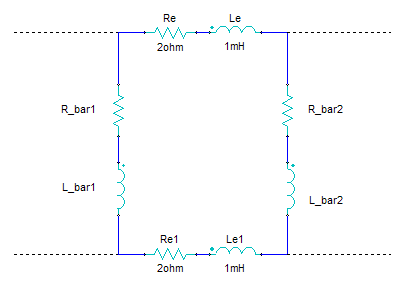End Connections in 2D Transient and Eddy Current
Choose this command to assign an end connection to a group of solid objects. This causes all objects in the group to be connected electrically in parallel using a finite resistance and inductance between adjacent objects.
End connections are primarily used in passive conductors (with no source current assigned) when modeling cylindrical squirrel cage induction motors.
For evenly distributed conductors, the End Resistance, Re, and the End Inductance, Le, are assigned between the ends of each conductor pair.
- Re and Le are the values on one end of the squirrel cage as shown in the schematic below. Therefore, in Maxwell 2D, you would enter 2 ohm and 1 mH for this squirrel cage.
- The current reported as EndConnection1 is the current in the first bar located counter clock-wise from the X axis.
- All objects included in End Connection automatically have Eddy Effects enabled.

For unevenly distributed conductors, the user supplied resistance and inductance values are scaled such that the supplied values are used directly for the conductor pair with the smallest angle between them. All other conductor pairs are assigned values that are scaled up according to the following equations:

Where qij is the angle between the conductor i and conductor j.
